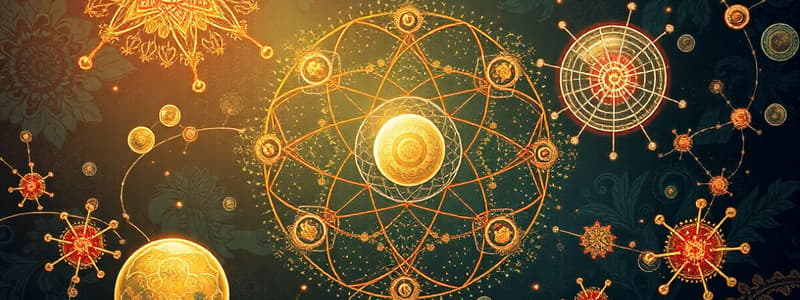Podcast
Questions and Answers
If an atom has an atomic number of 19 and a mass number of 39, how many neutrons does it have?
If an atom has an atomic number of 19 and a mass number of 39, how many neutrons does it have?
- 19
- 39
- 20 (correct)
- 58
Based on Rutherford's experiments, what did he conclude about the structure of an atom?
Based on Rutherford's experiments, what did he conclude about the structure of an atom?
- Atoms consist of a dense, positively charged nucleus surrounded by a cloud of negatively charged electrons. (correct)
- Atoms are made up of smaller, indivisible particles called atoms.
- Atoms are mostly empty space with a central nucleus surrounded by orbiting electrons.
- Atoms are solid spheres with a uniform distribution of positive and negative charges.
If an atom loses two electrons, what happens to its overall charge?
If an atom loses two electrons, what happens to its overall charge?
- It becomes more positive. (correct)
- It remains neutral.
- It becomes a different element.
- It becomes more negative.
What is the approximate mass, in grams, of a single proton?
What is the approximate mass, in grams, of a single proton?
Which of the following is NOT a conclusion Rutherford made about the atom's structure based on his alpha particle scattering experiment?
Which of the following is NOT a conclusion Rutherford made about the atom's structure based on his alpha particle scattering experiment?
Which of the following statements about isotopes is TRUE?
Which of the following statements about isotopes is TRUE?
What is the atomic number (Z) of an isotope of chlorine that has 18 neutrons?
What is the atomic number (Z) of an isotope of chlorine that has 18 neutrons?
An atom of carbon-14 has 6 protons and 8 neutrons. Which statement about carbon-14 is TRUE?
An atom of carbon-14 has 6 protons and 8 neutrons. Which statement about carbon-14 is TRUE?
The mass number of an isotope is determined by which of the following?
The mass number of an isotope is determined by which of the following?
Which of the following isotopes has the same number of neutrons as oxygen-16?
Which of the following isotopes has the same number of neutrons as oxygen-16?
Flashcards
Subatomic Particles
Subatomic Particles
Particles that make up an atom: protons, neutrons, and electrons.
Proton
Proton
A positively charged subatomic particle found in the nucleus of an atom.
Neutron
Neutron
A neutral subatomic particle found in the nucleus of an atom, with no charge.
Atomic Number
Atomic Number
Signup and view all the flashcards
Rutherford's Experiment
Rutherford's Experiment
Signup and view all the flashcards
Mass Number
Mass Number
Signup and view all the flashcards
Isotopes
Isotopes
Signup and view all the flashcards
Isotopic Symbol
Isotopic Symbol
Signup and view all the flashcards
Chemical Properties
Chemical Properties
Signup and view all the flashcards
Study Notes
Chapter One: Atoms, Molecules, and Ions
- Dalton's Atomic Theory postulates that all matter is composed of extremely small, indivisible particles called atoms. Atoms of the same element are identical in size, mass, and chemical properties. Atoms of different elements have different masses. Compounds are formed when atoms from different elements combine in fixed, whole-number ratios.
- Atoms are not created or destroyed in chemical reactions, rather rearranged to form new compounds.
- The Law of Definite Proportions states that all samples of a given compound contain the same proportion of elements by mass.
- The Law of Multiple Proportions states that when two elements form more than one compound, the various masses of one element combining with a fixed mass of the other element are in a ratio of small whole numbers.
- Dalton's atomic theory explains these laws by proposing that elements are made of atoms; different elements have different atoms with differing masses; and in compounds, atoms combine in definite proportions.
Subatomic Particles and the Structure of the Atom
- Atoms are composed of three subatomic particles: electrons, protons, and neutrons.
- Electrons have a negative charge, protons have a positive charge, and neutrons have no charge.
- Protons and neutrons are located in the atomic nucleus, a dense central core.
- Electrons are located outside the nucleus in regions called electron shells.
- The mass of a proton and a neutron is approximately the same (1.673 x 10^-24 g).
- The mass of an electron is much smaller (9.11 x 10^-28 g).
Atomic Number and Mass Number
- Atomic number (Z) is the number of protons in the nucleus of an atom.
- Mass number (A) is the sum of the number of protons and neutrons in the nucleus.
- Isotopes are atoms of the same element that have different numbers of neutrons (and thus different mass numbers).
Molecules and Ions
- A molecule is a neutral group of two or more atoms held together by covalent bonds.
- An ion is an atom or group of atoms that has a net positive or negative charge.
- Cations are positive ions, formed by losing electrons.
- Anions are negative ions, formed by gaining electrons.
- Polyatomic ions are charged groups of two or more atoms covalently bonded.
Chemical Formulas
- Molecular formulas show the exact number of atoms of each element in a molecule.
- Empirical formulas show the simplest whole-number ratio of atoms in a compound.
- Ionic compounds have formulas that represent the simplest whole-number ratio of ions.
Naming Inorganic Compounds
- Naming inorganic compounds follows systematic rules based on the type of compound.
- Binary ionic compounds: The metal cation is named first, followed by the nonmetal anion.
- Binary molecular compounds: Prefixes indicate the numbers of atoms of each element in the molecule.
- Acids: Contain hydrogen as the first element and have names that end in -ic or -ous.
- Polyatomic ions are groups of atoms that carry a charge. Their names and formulas are needed to name the ionic compounds involving polyatomic ions.
Studying That Suits You
Use AI to generate personalized quizzes and flashcards to suit your learning preferences.




